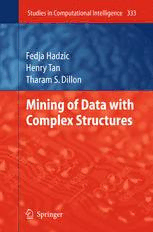Table Of ContentFedjaHadzic,HenryTan,andTharamS.Dillon
MiningofDatawithComplexStructures
StudiesinComputationalIntelligence,Volume333
Editor-in-Chief
Prof.JanuszKacprzyk
SystemsResearchInstitute
PolishAcademyofSciences
ul.Newelska6
01-447Warsaw
Poland
E-mail:[email protected]
Furthervolumesofthisseriescanbefoundonour
homepage:springer.com Vol.322.BrunoBaruqueandEmilioCorchado(Eds.)
FusionMethodsforUnsupervisedLearningEnsembles,2010
Vol.311.JuanD.Vela´squezandLakhmiC.Jain(Eds.) ISBN978-3-642-16204-6
AdvancedTechniquesinWebIntelligence,2010
Vol.323.YingxuWang,DuZhang,andWitoldKinsner(Eds.)
ISBN978-3-642-14460-8
AdvancesinCognitiveInformatics,2010
Vol.312.PatriciaMelin,JanuszKacprzyk,and ISBN978-3-642-16082-0
WitoldPedrycz(Eds.)
Vol.324.AlessandroSoro,VargiuEloisa,GiulianoArmano,
SoftComputingforRecognitionbasedonBiometrics,2010
andGavinoPaddeu(Eds.)
ISBN978-3-642-15110-1
InformationRetrievalandMininginDistributed
Vol.313.ImreJ.Rudas,Ja´nosFodor,and Environments,2010
JanuszKacprzyk(Eds.) ISBN978-3-642-16088-2
ComputationalIntelligenceinEngineering,2010
Vol.325.QuanBaiandNaokiFukuta(Eds.)
ISBN978-3-642-15219-1
AdvancesinPracticalMulti-AgentSystems,2010
Vol.314.LorenzoMagnani,WalterCarnielli,and ISBN978-3-642-16097-4
ClaudioPizzi(Eds.)
Vol.326.SherylBrahnamandLakhmiC.Jain(Eds.)
Model-BasedReasoninginScienceandTechnology,2010
AdvancedComputationalIntelligenceParadigmsin
ISBN978-3-642-15222-1
Healthcare5,2010
Vol.315.MohammadEssaaidi,MicheleMalgeri,and ISBN978-3-642-16094-3
CostinBadica(Eds.)
IntelligentDistributedComputingIV,2010 Vol.327.SlawomirWiakand
ISBN978-3-642-15210-8 EwaNapieralska-Juszczak(Eds.)
ComputationalMethodsfortheInnovativeDesignof
Vol.316.PhilippWolfrum ElectricalDevices,2010
InformationRouting,CorrespondenceFinding,andObject ISBN978-3-642-16224-4
RecognitionintheBrain,2010
ISBN978-3-642-15253-5 Vol.328.RaoulHuysandViktorK.Jirsa(Eds.)
NonlinearDynamicsinHumanBehavior,2010
Vol.317.RogerLee(Ed.) ISBN978-3-642-16261-9
ComputerandInformationScience2010
ISBN978-3-642-15404-1 Vol.329.SantiCaballe´,FatosXhafa,andAjithAbraham(Eds.)
IntelligentNetworking,CollaborativeSystemsand
Vol.318.OscarCastillo,JanuszKacprzyk, Applications,2010
andWitoldPedrycz(Eds.) ISBN978-3-642-16792-8
SoftComputingforIntelligentControl
andMobileRobotics,2010 Vol.330.SteffenRendle
ISBN978-3-642-15533-8 Context-AwareRankingwithFactorizationModels,2010
ISBN978-3-642-16897-0
Vol.319.TakayukiIto,MinjieZhang,ValentinRobu,
Vol.331.AthenaVakaliandLakhmiC.Jain(Eds.)
ShaheenFatima,TokuroMatsuo,
NewDirectionsinWebDataManagement1,2011
andHirofumiYamaki(Eds.)
ISBN978-3-642-17550-3
InnovationsinAgent-BasedComplex
AutomatedNegotiations,2010 Vol.332.JianguoZhang,LingShao,LeiZhang,and
ISBN978-3-642-15611-3 GraemeA.Jones(Eds.)
IntelligentVideoEventAnalysisandUnderstanding,2011
Vol.320.xxx ISBN978-3-642-17553-4
Vol.321.DimitriPlemenosandGeorgiosMiaoulis(Eds.) Vol.333.FedjaHadzic,HenryTan,andTharamS.Dillon
IntelligentComputerGraphics2010 MiningofDatawithComplexStructures,2011
ISBN978-3-642-15689-2 ISBN978-3-642-17556-5
Fedja Hadzic,Henry Tan,and Tharam S.Dillon
Mining of Data with Complex
Structures
123
Dr.FedjaHadzic Prof.TharamS.Dillon
Digital Ecosystems and Business Digital Ecosystems and Business
Intelligence Institute, Intelligence Institute,
Curtin University Curtin University
GPO Box U1987 GPO Box U1987
Perth, Western Australia 6845 Perth, Western Australia 6845
Australia Australia
Dr.HenryTan
183rd St. SE., 3514
98012 Bothel Washington
USA
ISBN 978-3-642-17556-5 e-ISBN 978-3-642-17557-2
DOI 10.1007/978-3-642-17557-2
Studiesin Computational Intelligence ISSN1860-949X
(cid:2)c 2011 Springer-VerlagBerlin Heidelberg
Thisworkissubjecttocopyright.Allrightsarereserved,whetherthewholeorpart
of the material is concerned, specifically therights of translation, reprinting,reuse
ofillustrations, recitation,broadcasting, reproductiononmicrofilm orinanyother
way, and storage in data banks. Duplication of this publication or parts thereof is
permittedonlyundertheprovisionsoftheGermanCopyrightLawofSeptember9,
1965, in its current version, and permission for use must always be obtained from
Springer. Violations are liable to prosecution undertheGerman Copyright Law.
The use of general descriptive names, registered names, trademarks, etc. in this
publication does not imply, even in the absence of a specific statement, that such
names are exempt from the relevant protective laws and regulations and therefore
free for general use.
Typeset&CoverDesign:ScientificPublishing ServicesPvt. Ltd., Chennai, India.
Printed on acid-free paper
9 8 7 6 5 4 3 2 1
springer.com
Iwouldliketo equallydedicatethisbookto
myneglected darlingMisheleforher
everlastinglove, patienceand understanding
duringmy wholeresearch career and tomy
mother,who hasprovidedstrongsupportto
methroughoutmylifeand inspirationtotake
a researchpath.
Fedja
I thankmywifeTheresia andmytwo
daughtersEnrica& Eideeforconsistently
givingmecourageandinspiration.Lastbut
notleast,Idevotethebooktomyparents,
who havebeen instrumentalin guidingmy
lifeandencouragingme tosucceed.
Henry
Wewouldallliketo thankProfessor
ElizabethChang forprovidinga unique
environmentwithintheDigitalEcosystems
andBusinessIntelligenceInstitutethat
allowedus toconcentrateontop level
research.
Tharam,Fedjaand Henry
Foreword
Withtherapiddevelopmentofcomputertechnologyandapplications,datacollected
is mountingup both in size and in complexityon interconnectionsand structures.
Thus, “mining of data with complex structures” becomes an increasingly impor-
tant task in data mining. Although there are many books on data mining, this is
a unique book dedicatedto mining of data with complexstructures, especially on
treestructures.Treestructureshavemanyimportantapplications.XMLdocuments,
ontologicalstructures,manysemanticstructuresontheinternet,structuresinmany
socialandeconomicorganizations,Weblogstructures,patientrecordsinhealthcare,
andsoonaretree-structureddata.
Despite of the existence of a lot of general data mining algorithms and meth-
ods,tree-structuredataminingdeservesdedicatedstudyandin-depthtreatmentbe-
causeofits uniquenatureofstructureandordering,whichleadsto manyinterest-
ing knowledge to be discovered, including simple subtree patterns, ordered sub-
treepatterns,distance-constrainedembeddedsubtrees,variouskindsofapplication-
orientedsubtreepatterns,andsoon;andthesekindsofpatternswillnaturallypro-
mote the development of new pattern analysis methods. From the discussions of
various kinds of tree pattern mining methods, one can see that tree pattern min-
ing contains many challenging research problems, and recent research has made
goodcontributionstotheunderstandingandsolvingtheproblems.Moreover,start-
ing with tree pattern mining, this book also discusses methods for mining several
other kinds of patterns with complex structures, including frequent subsequences
andsubgraphs.
Thisbook,byFedjaHadzic,HenryTan,andTharamS.Dillonprovidesacom-
prehensivecoverageonthesetopicstimely,withconcisenessandclearorganization.
Theauthorsofthebookareactiveresearchersontreepatternminingandhavemade
good contributions to the progress of this dynamic research theme. This ensures
thatthebookis authoritativeandreflectsthe currentstate of theart. Nevertheless,
thebookgivesabalancedtreatmentonawidespectrumoftopics,wellbeyondthe
authors’ownmethodologiesandresearchscopes.
Miningdatawithcomplexstructuresisstillafairlyyounganddynamicresearch
field. This book may serve researcher and application developers a comprehen-
VIII Foreword
sive overview of the general concepts, techniques, and applications on mining of
datawithcomplexstructuresandhelpthemexplorethisexcitingfieldanddevelop
newmethodsandapplications.Itmayalsoservegraduatestudentsandotherinter-
estedreadersageneralintroductiontothestate-of-the-artofthispromisingresearch
theme.
Ifindthebookisenjoyabletoread.Ihopeyoulikeittoo.
ProfessorJiaweiHan
UniversityofIllinois
Preface
For many practical applications in domains such as biology, chemistry, network
analysis, Web Intelligence applications, the expressional power of relational data
is not capable of effectively capturing the necessary relationships and semantics
that need to be expressed in the domain. This gave rise to semi-structured data
sources, capable of dealing with 2-dimensional relationships among data entities
thataremanifestedthroughstructuralrelationshipsamongattributenodes.Someex-
amplesareXMLdatabases,RDFdatabases,moleculardatabases,graphdatabases,
etc. Generally speaking,developingdata mining methodsfor mining of data with
complexstructuresisanon-trivialtaskandmanyissuesexistthatneedtobecare-
fullyconsidered.Theproperuseofsuchmethodsneedstobeexplainedtotheprac-
titionersintheapplicationthatmaynotbesofamiliarwiththearea.Intheproposed
bookweintendtopreciselydefinetheexistingproblemsassociatedwithminingof
datawithcomplexstructures,includingtrees,graphsandsequences,withastronger
focusontree-structureddata.Theimplicationsandpossibleapplicationsformining
of different subpattern types under differentconstraints are discussed. We look at
the currentapproachesfor solving the differentsub-problemsin the area and dis-
cusstheir advantagesanddisadvantages.A numberofimportantapplicationareas
arediscussed,whereweexplainhowthedescribedmethodscaneffectivelybeused
fortheextractionofknowledgepatternsusefulforthedomain.
The book overview is as follows. An introductionto the general aspects of the
field ofknowledgediscoveryand dataminingispresentedin Chapter1, together
withanoverviewofthesourcesofdatawithcomplexstructuresandthechallenges
ofminingsuchdata.Chapter2isconcernedwiththeproblemofminingfrequent
patternsfromdatawheretheunderlyinginformationcanberepresentedasatree.We
firstdiscussthemotivationbehindtheproblemtogetherwithanexplanationofhow
agreatdealofinformationcanbeeffectivelyrepresentedasatreestructure.Wethen
show the importanceof extractingfrequentpatternsfromsuch data, knownas the
frequentsubtreeminingproblem.Thisproblemisthemainfocusofthisbookand
detaileddefinitionsofsomegeneraltreeconceptsareprovidedtogetherwithmany
specifictermsnecessaryforunderstandingtheproblemingeneral.Thisinvolvesthe
types of subtree patterns consideredand existing frequencycriteria definitions. In
X Preface
Chapter3welookatthemajorissuesthatarisewhendevelopingalgorithmsforthe
frequentsubtreeminingproblem.A numberofdifferentapproachesare discussed
and their advantagesand disadvantageshighlighted.At the end of the chapter, an
overviewoftheexistingfrequentsubtreeminingalgorithmsisprovided.TheTree
ModelGuided(TMG)frameworkforfrequentsubtreeminingisdiscussedinChap-
ter 4. Here we discuss the underlying strategy of the TMG framework when ap-
proachingeachoftheimplementationaspectsdiscussedinChapter3.Chapter5ex-
plainsindetailthegeneralmechanismoftheTMGframeworkanditsmostgeneric
implementationforminingofinduced/embeddedorderedsubtrees.Wealsoprovide
a mathematical model of the worst case analysis of a model-guided enumeration
approach,andusethismodeltotheoreticallyandpracticallyshowthedifferencesin
complexitybetweenminingofinducedandembeddedsubtrees.Theapproachisex-
perimentallyevaluatedbycomparingitwiththecurrentstate-of-the-arttechniques.
Anumberofdifferentreal-worldandsyntheticdatasetswithvaryingtreecharacter-
isticsareusedtohighlighttheimportantdifferencesandadvantages/disadvantages
of the differentapproaches.We then explainthe necessary extensionsto this gen-
eralTMGframeworktoenableitsuseforminingofinduced/embeddedunordered,
andordered/unordereddistance-constrainedembeddedsubtrees,inChapters6and
Chapter 7, respectively. Each extension is accompanied with a motivation of the
problem,and a numberof experimentswith real world and synthetic datasets and
comparisonstothecurrentstate-of-the-artapproaches(whenavailable).Theprob-
lemofminingmaximalandclosedfrequentsubtreesisaddressedinChapter8.A
number of existing solution techniquesare described, with one popular algorithm
beingexplainedinmoredetail.Chapter9takesthefrequentsubtreeminingprob-
lem and places it within the context of general knowledge analysis. The implica-
tionsbehindminingdifferentsubtree typesusing differentsupportdefinitionsand
constraints are highlighted with the aid of motivating examples. A number of in-
dependentapplicationsarethendiscussedrelatedtoanalysisofhealthinformation,
webdata,knowledgestructuresforthepurposeofmatching,andproteinstructures.
TheproblemofminingsequentialdataisaddressedinChapter10.Itstartswiththe
necessaryformulationsoftheproblem,andlooksatsomeexistingsequencemining
algorithmsandapplications.Byconsideringasequenceasaspecialtypeoftree,we
explainthe way that the TMG frameworkcan be used to mine sequentialdata. In
Chapter11,thegraphminingproblemisformallydefinedandexistingapproaches
to the problem explained, with an overview of some existing algorithms. To con-
cludethebook,inChapter12,weconsiderseveralfutureresearchdirectionsinthe
areaoffrequentsubtreemining,anddiscussanumberofemergingapplicationsof
thetechniquestosomeimportantresearchareas.
Author Introduction
DrFedjaHadzicreceivedhisPhDfromCurtinUniversityofTechnologyin2008.
His PhD thesis is entitled:“Advancesin KnowledgeLearningMethodologiesand
theirApplications”.HeiscurrentlyaResearchFellowattheDigitalEcosystemsand
BusinessIntelligenceInstituteoftheCurtinUniversityofTechnology.Hehascon-
tributedinanumberoffieldsofdataminingandknowledgediscoveryandpublished
hisworkinanumberofrefereedconferencesandjournals.Hisresearchinterestsin-
cludedataminingandAIingeneralwithmorefocusontreemining,graphmining,
neuralnetworks,knowledgematchingandontologylearning.
Dr Henry Tan has received his PhD from University of Technology, Sydney in
2008.His PhD thesis is entitled:“Tree ModelGuided (TMG)Enumerationas the
BasisforMiningFrequentPatternsfromXMLDocuments”.Hehasbecomeanex-
pertinthefieldofdataminingwithanumberofpublicationsinrefereedconferences
andjournals.OtherresearchinterestsincludeAI, neuralnetworks,gameand soft-
waredevelopment
Professor Tharam Dillon is an expert in the field of software engineering, data
miningXMLbasedsystems,ontologies,trust,securityandcomponent-orientedac-
cesscontrol.ProfessorDillonhaspublishedfiveauthoredbooksandfourco-edited
books. He has also published over 750 scientific papers in refereed journals and
conferences.Overthelast fifteenyears,hehasmorethan4500citations.Manyof
hisresearchoutcomeshavebeenappliedbyIndustryworldwide.Thisindicatesthe
highimpactofhisresearchwork.

